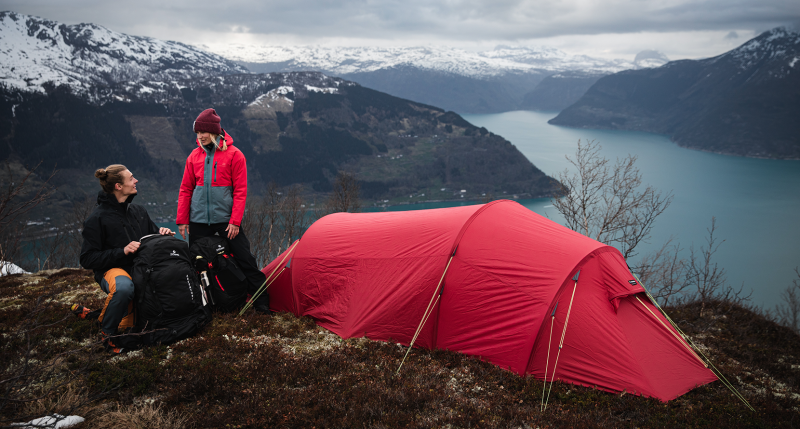
How do I choose the right tent?
Finding the right tent for your particular needs can feel difficult and the questions can be many. What should I consider when buying a tent? Should I buy a dome tent or tunnel tent? Which color is the best? Which water column should a tent have? We understand that there can be many questions, which is why we at Outnorth have put together a guide on how to choose the right hiking tent tailored for your adventures.
What to consider when choosing a tent
- There are two different models to choose from – tunnel tent and dome tent
- Tunnel tents are storm-proof and easy to pitch, but have lower ceiling height and poorer ventilation
- Dome tents have good ceiling height, ventilation and can basically be placed anywhere, but can be more difficult to pitch
- You should choose a 4-season tent if you are camping in the winter, otherwise a 3-season tent will be enough
- The size of the tent depends on the number of people who will sleep in the tent
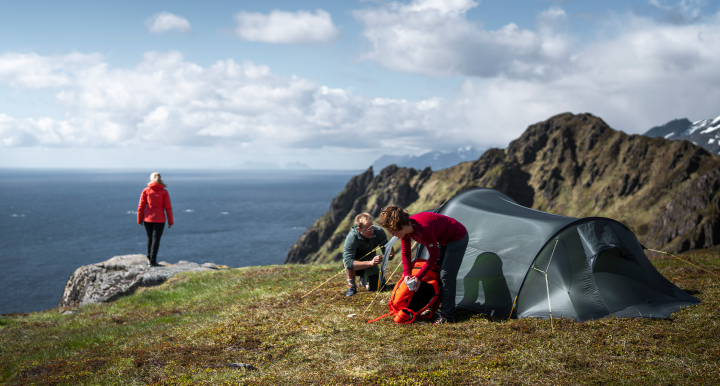
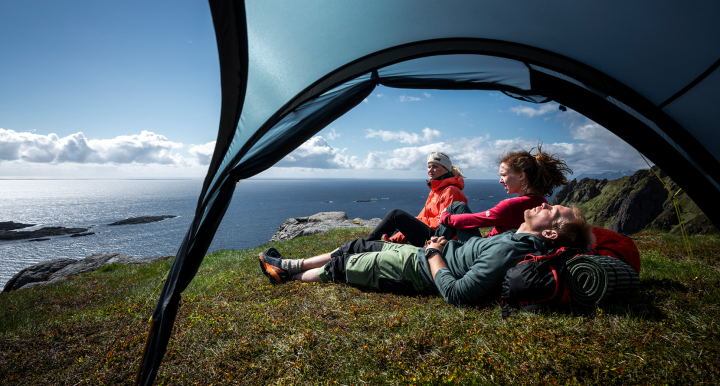
Should I choose a tunnel tent or a dome tent?
There are generally two different tent models to choose from; tunnel and dome. Which one to choose depends on where, when and how you will use your tent. Depending on when you will be camping, it may also be a good idea to consider whether you should choose a 3-season tent or a 4-season tent. The majority of all tents are 3-season tents, they are designed to be used during spring, summer and autumn. They offer good ventilation but are also durable enough to withstand rain and wind. A 4-season tent can be used during all four seasons; spring, summer, autumn and winter. Unlike the 3-season tents, these tents have a more durable construction with a tent fabric that goes all the way down to the ground to be covered by snow for extra insulation.
Tunnel tents
A tunnel tent is easy to pitch and, thanks to its low profile, is very storm-proof. Pitching a tunnel tent is easy; the inner and outer tent sit together and to pitch it, you usually just thread two poles into the respective pole channel and anchor it to the ground. However, it may be good to bear in mind that a tunnel tent is not as self-supporting as a dome tent, so it is not suitable to use a tunnel tent on bare rocks where it is difficult to anchor the tent. Most tunnel tents also have a well-sized apse (can be compared to an awning) that provides space for both cooking and equipment. Due to the tunnel tent's low profile and shape, however, the seating height and ventilation options may be perceived as worse than in a dome tent.
Practical tunnel tents
Dome tents
A dome tent offers generous seating height, good ventilation and even better views. With a dome tent, you can be flexible in where you choose to camp – how about one night in the forest and the other night on bare rocks in the archipelago? Thanks to the dome tent's relatively self-supporting construction, they are optimal on rocks in the archipelago as they do not require the same anchoring as a tunnel tent. Dome tents have cross-laid arches that resist wind well and also keep the tent fabric properly taut, which prevents a damp inner tent from soaking your sleeping bag. Its steep walls also allow water and snow to easily run off the flysheet.
Thanks to the beneficial ventilation options and the fact that the inner and outer tents are treated separately, the tent dries quickly after a rainy night. The downside of pitching the inner and outer tent separately is that it can be difficult to handle when it rains or is very windy. An other positive thing about dome tents is that they usually have openings on both sides, alternatively a transparent inner tent that can work on its own in warm weather – this, as you can imagine, provides optimal conditions for a nice view from the tent!
Stable and spacious dome tents
Tunnel tent
- Easy to pitch as inner and outer tents are pitched together
- More suitable in rain and wind since the inner and outer tents are pitched at the same time
- Generally lower ceiling height
- Lots of space in relation to weight
- Slightly worse ventilation possibilities
- Not as self-supporting, which can be perceived as limiting
Dome tent
- Inner and outer tents are separated – positive for drying time and view but problematic when pitching the tent in rain and wind
- Generous ceiling height
- The weight per person is usually slightly higher than for a tunnel tent
- Good ventilation
- Usually self-supporting which allows you to place it on bare rocks
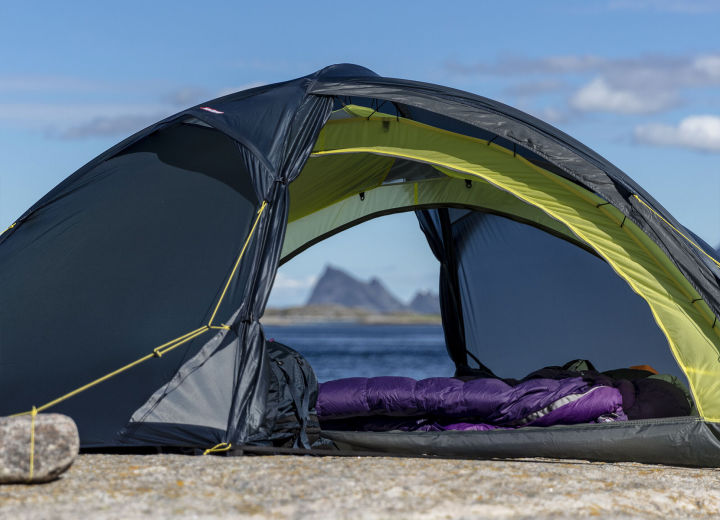
How big should the tent be?
The size of the tent depends on how many people will sleep in the tent. Think about how many people the tent must fit – do you usually camp alone, with a friend or with your partner and children? No matter what your needs look like, at Outnorth we have a variety of tent models to choose from. Choose between one-person, two-person, three-person or four-person tents. If there are more than four of you, we recommend that you look at two tents to cover your needs.
On all tents in Outnorth's range, we indicate how many people it fits. You can easily choose to filter by number of people to only see tents for a certain number of people. If you prioritize comfort over low weight, you can advantageously choose a tent that holds one person more than you actually need for increased living space and room for packing. If you are going to camp by yourself, you can, for example, choose a two-man tent for increased comfort.
If you are going on a longer hike or expedition, it is important to choose a tent that you are able to carry. For a shorter hike, however, it may be worth buying a slightly larger and heavier tent for increased comfort.
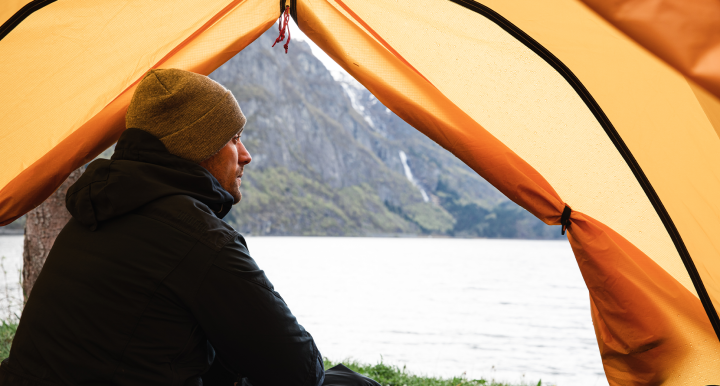
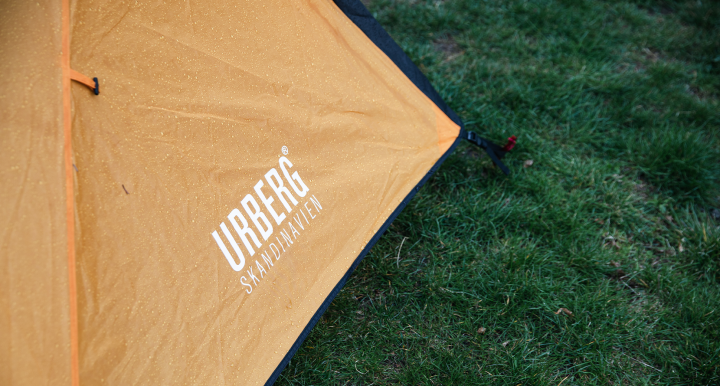
The tent's functions and characteristics
A tent is above all a portable shelter that protects against weather, wind, people and animals. But a tent also has other important properties. Below, you can read about features and characteristics that may be good to look out for when looking for tents.
Ventilation: Good ventilation leads to a dry and comfortable sleep, but keep in mind that mesh panels close to the floor are also a way in for rain and drafts. Closeable mesh panels are preferable, then you can choose whether you want them open or not, just like a window. Also look for ventilation options in the outer tent.
Weight: Light weight is preferable on a long and demanding hike. But low weight can entail less comfort, so think about what is most important to you.
The color of the tent: The color of the flysheet is important. A dark fabric (usually dark green) provides less general light inside the tent but blends into nature better than a colorful tent. A brighter and more colorful tent provides better light inside and provides good visibility from afar. This is beneficial in the mountains when the weather is bad, both for you to find your way back to your tent and for others to be able to find you in case of an emergency.
Material: Tent fabrics are usually made of nylon or polyester. Nylon is an elastic and durable material that usually costs a little more, but can stretch when wet. Polyester usually weighs and rustles more than nylon but has a better durability against the sun's rays. The tent floor usually has a coating of polyurethane, which makes the floor durable.
Entrances and apses: Several entrances can be practical if you are several people in the tent, then it is easier to get in and out of the tent without having to step over each other. If you have a lot of packing, it might be a good idea to look at how many and how big the apses are, so that you can fit all the packing in your tent.
Water column: Water column is a measure of how high water pressure the material can withstand. The higher the number, the better the rain resistance, but a higher rain resistance also results in poorer breathability. The water resistance of the tent fabric and the tent floor are different, where the floor needs a higher water resistance.
Good luck with your choice of tent!